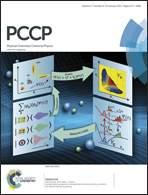Protein loading into porous CaCO3 microspheres: adsorption equilibrium and bioactivity retention†
Abstract
Formulation of proteins into particulate form is a principal strategy to achieve controlled and targeted delivery, as well as to protect fragile protein molecules. Control over size, mechanical properties, and surface area (porosity) of particulate proteins has been successfully achieved by hard templating under mild conditions using porous CaCO3 microspheres. A crucial step in this approach, which determines protein content, is the loading of proteins into the CaCO3 microspheres. In this study, the adsorption of different proteins into the microspheres has been investigated. Proteins differing in characteristics such as molecular weight and charge have been employed: catalase (Cat), insulin (Ins), aprotinin (Apr), and protamine (Pro). Thermodynamics of adsorption equilibria have been studied, together with quantitative and qualitative analysis of protein loading and distribution in the microspheres. Protein interaction with the CaCO3 microspheres is not limited by the diffusion of protein molecules (protein dimensions are significantly smaller than microsphere pores) but is determined by the protein affinity for the microsphere surface. Cat and Ins bind much more strongly to the microspheres than Apr and Pro, which can be explained by electrostatic attractive forces. Protein binding/release and protein biological activity have been investigated as a function of pH. It is shown that pH variation during the adsorption process plays a principal role and defines not only the amount of protein adsorbed/released but also protein biological activity. Protein adsorption and microsphere elimination (by EDTA) do not affect protein bioactivity. In addition to applications for protein particle/capsule formulations, the findings of this study might help in understanding protein interactions with carbonate minerals such as calcium carbonate, which is used as a natural material for multiple applications.


 Please wait while we load your content...
Please wait while we load your content...